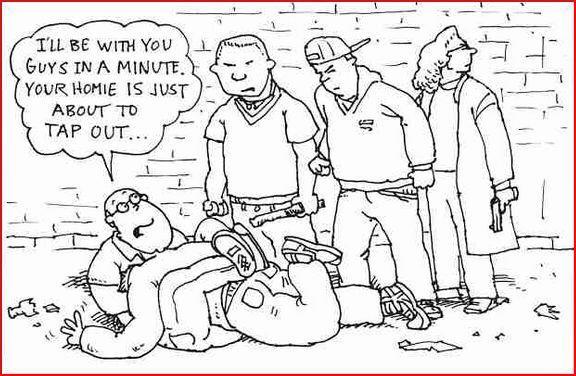Often the discussion comes up that people should practice grappling because thats what will happen in a fight. Often they mention that 70% of fights end up on the ground. Whilst personally I don't subscribe to that high percentage, it is almost guaranteed that 100% start with both feet firmly planted on the ground.
What contributes to this view is the popularity of BJJ and MMA, with the latter responsible for the popularity of BJJ as it is seen that in the environment of MMA fights, grapplers were often dominant. So it's no surprise that this is the opinion held by many. Is it therefore important to train lots in grappling?
I say NO. Let me clarify: Firstly, I'm going to state that it is good to get a bit of grappling experience, so you know what it 'feels' like. But I'm saying NO to training it a LOT. Why? First off, it is very unlikely that in a street fight, you will be facing an (experienced) grappler. I can say this because of statistics. In the UK (where I live) there are approximately 67million people, of this, according to sport England data of 2022, about 237 thousand practice martial arts. That's one in 280 persons. Of that amount a large proportion will be children. In practice it is probably about 2/3rd children and teens, vs adults. That changes the ratio to about one in 5-600... All other potential opponents have no martial arts background whatsoever so their fighting skills are not going to be of a high quality. That doesn't mean they won't try it (they see it on the TV all the time), but as a trained martial artist, you should be reasonably succesful in fending off their attacks from a stand up position, which is far more favourable. You retain mobility, so you can run away as soon as there is a chance, but one other big factor is important: Once on the ground, you are very much in a one on one environment with very little to no situational awareness. YOu're not going to see his budy (or a stranger) suddenly getting in on the action and kicking you in the head or worse.. Also you're not going to see any concealed bladed weapon he might be carrying so you could get stabbed in this situation, another reason to stay on your feet and keep him at a distance.
So instead of spending time learning intricate grappling techniques and submissions etc, learn take down defenses, and how to get back up QUICK, when you're on the ground. Focus on those elements of ground fighting, and you will be best prepared for the majority of street encounters you are likely to find yourself in, at least in the UK. Your mileage may vary, but thats the situation where I live.
Walk On!





